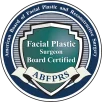Septoplasty in NYC
THE PROCEDURE
Improving Form And Function Of The Nose
Each year thousands of people undergo surgery of the nose. Nasal surgery may be performed for cosmetic purposes, or a combination procedure to improve both form and function. It also may alleviate or cure nasal breathing problems, correct deformities from birth or injury, or support an aging, drooping nose.
Patients who are considering nasal surgery for any reason should seek a doctor who is a specialist in nasal airway function, as well as plastic surgery. This will ensure that efficient breathing is as high a priority as appearance.
When Should Surgery Be Considered to Correct a Chronically Stuffy Nose?
Millions of Americans perennially suffer the discomfort of nasal stuffiness. This may be indicative of chronic breathing problems that don't respond well to ordinary treatment. The blockage may be related to structural abnormalities inside the nose or to swelling caused by allergies or viruses.
There are numerous causes of nasal obstruction. A deviated septum (the partition between the nostrils) can be crooked or bent as the result of abnormal growth or injury. This can partially or completely close one or both nasal passages. The deviated septum can be corrected with a surgical procedure called septoplasty. Cosmetic changes to the nose are often performed at the same time, in a combination procedure called septorhinoplasty.
Overgrowth of the turbinates is yet another cause of stuffiness. (The turbinates are the tissues that line the inside of the nasal passages.) Sometimes the turbinates need treatment to make them smaller and expand the nasal passages. Treatments include injection, freezing, and partial removal. Allergies, too, can cause internal nasal swelling, and allergy evaluation and therapy may be necessary.

Can Surgery Correct a Stuffy, Aging Nose?
Aging is a common cause of nasal obstruction. This occurs when cartilage in the nose and its tip are weakened by age and droop because of gravity, causing the sides of the nose to collapse inward, obstructing air flow. Mouth breathing or noisy and restricted breathing are common.
Try lifting the tip of your nose to see if you breathe better. If so, the external adhesive nasal strips that athletes have popularized may help. Or talk to a facial plastic surgeon/otolaryngolgist about septoplasty, which will involve trimming, reshaping or repositioning portions of septal cartilage and bone. (This is an ideal time to make other cosmetic improvements as well.) Soft silicone splints are placed in the nostrils for 1 week to hold the septum in its new position. Patients may experience some internal swelling for a week or two. However, after the silicone splints are removed, most people enjoy a dramatic improvement in breathing that continues several weeks after surgery.
REVIEWS
FEATURED testimonials
FAQs
Frequently asked questions
No. While septoplasty is a surgical procedure and does carry risks such as bleeding, infections, and numbness, it is not typically considered a major surgery. However, any surgical procedure should be approached with caution especially when general anesthesia is involved. Before a septoplasty in New York City, your surgeon will thoroughly review your medical history to ensure you are a good candidate for the procedure and at low risk of any complications.
A septoplasty in Manhattan is performed as an outpatient procedure allowing patients to return home the same day of the procedure. Immediately following the procedure, swelling and discomfort can be expected and will resolve within the first week. It can take up to three to four weeks before patients can return to normal activities, and up to three months before the nose is fully healed from the procedure.
A deviated septum surgery can significantly improve a patient’s quality of life, improving their breathing, quality of sleep, and nasal discomfort. Therefore, for many, it is a life-changing procedure. However, the benefits must be weighed against the risks of the surgery to make a well-informed decision and to determine if the procedure is right for you.
Obtaining a consultation with one of the top septoplasty doctors in New York City will provide a customized treatment recommendation, as well as the expected outcomes of the procedure.
Yes. The results of a septoplasty provide a permanent fix for the complications associated with a deviated septum. Unlike many non-surgical treatment options, such as nasal strips and medications, which provide temporary relief, a septoplasty targets the root cause of the problem to provide long-lasting relief. By addressing the soft-tissue and bony issues resulting in a deviated septum, patients may experience a significant life-long improvement in their breathing and nasal comfort.
While the benefits of septoplasty and sinus surgery can be profound for patients, it is important to consider the potential risks associated with the procedure. One consideration should include the discomfort and pain associated with the procedure.
After septoplasty, it is not uncommon to have swelling, discomfort, and temporary sensory changes such as numbness and tingling. While these symptoms typically resolve within the first week of surgery they can produce significant discomfort for some patients and thus must be considered when deciding to proceed with the procedure.
New research shows that patients undergoing a septoplasty can experience varying degrees of changes in voice quality after surgery. These changes are often subtle but can be apparent to trained listeners. Patients can also perceive these changes to some extent but these alterations do not typically cause any interference in their daily lives.




